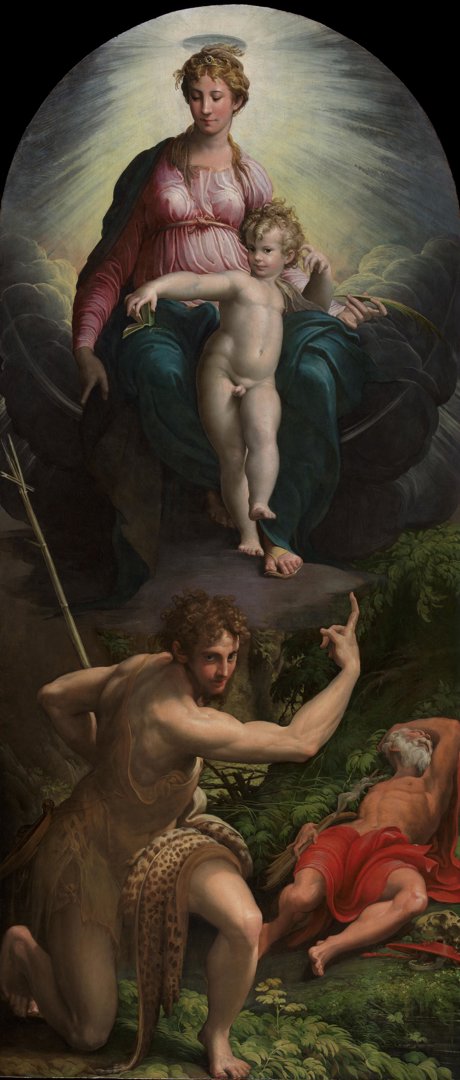Parmigianino: The Vision of Saint Jerome
In winter 2024, the National Gallery will celebrate the first public display in a decade, following conservation, of a masterpiece of Italian Mannerism, Parmigianino’s Madonna and Child with Saints, also known as ‘The Vision of Saint Jerome’. It is the only major altarpiece by Parmigianino in UK collections.
This will be the first exhibition dedicated to the painting since it was presented to the Gallery in 1826, two years after our foundation. Part of our Bicentenary celebrations, this exhibition presents this pre-eminent work afresh to the public, showcasing its place within the development of 16th-century Central Italian painting and the history of our collection.
'The Madonna and Child with Saints' was undertaken by Parmigianino when he was just 23 years old during his brief period in Rome, where he worked from 1524-‒27. It was intended to adorn a chapel in the church of San Salvatore in Lauro belonging to the Caccialupi, a family of noted church officials. Depicting a Madonna and Child with Saints John the Baptist and Jerome at her feet, it was an important public commission for the young artist, but it was to be his first and the only one he finished in Rome.
According to Giorgio Vasari, Parmigianino was at work on this very altarpiece in 1527 during the disastrous Sack of Rome. When the imperial troops of Charles V broke into his studio, they were so amazed by what they saw that they allowed him to continue, demanding he make drawings for them in exchange for leaving him unharmed. Parmigianino eventually fled Rome, never to see his greatest achievement to date installed. The painting was hidden away for safekeeping, and only recovered long after the artist’s death when it was transferred by the patron’s heirs to their family church in Città di Castello.
Parmigianino was one of the most exemplary and prolific draughtsmen of the 16th century. The numerous surviving preparatory drawings for the altarpiece demonstrate his restless creative dedication to the project. This focused exhibition reunites for the first time a selection of these with the painting. From atmospheric, velvety chalk studies to spritely, swirling pen and ink sketches, it offers an unique opportunity to rediscover the painting from early concept ideas to meticulously finished final designs, illuminating the artist’s dynamic visual thinking through the elegant vivacity of his line and mastery across a variety of media.
A native of the Northern Italian city of Parma after which he was named, Girolamo Francesco Maria Mazzola (1503‒-1540) was a child prodigy. The grace, ingenuity, and refinement of execution already evident in his early work led to him being hailed as a ‘Raphael reborn’. In 1524 he travelled to Rome, where he was presented to Pope Clement VII to great acclaim. He immersed himself in the art of Raphael and Michelangelo, as well as that of antiquity;, all influences that inform the altarpiece. Yet while artists such as Raphael were often admired for their naturalism, Parmigianino increasingly moved towards a more stylised method of representation. With a distinct combination of strange spatial organisation, elongated figures, and unusual iconography, Parmigianino pushed the development of 16th-century art in a new direction.
Dr Matthias Wivel, Curator of 16th-century Italian Paintings, says:
'It will be such a thrill to have this masterwork back on our Gallery walls, its visionary qualities once again on display to the public. It is also thrilling to be able to display alongside a selection of Parmigianino’s outstanding preparatory drawings, allowing us all to partake vicariously in his dynamic, fluid and ever-shifting creative process. I have little doubt that this show will be a transporting experience.’
The H J Hyams Exhibition Programme
Supported by The Capricorn Foundation
Notes to editors
Image credits
NG33
Parmigianino
'The Madonna and Child with Saints John the Baptist and Jerome'
1526‒-7
Oil on poplar
342.9 x 148.6cm
© The National Gallery, London
The National Gallery
The National Gallery is one of the greatest art galleries in the world. Founded by Parliament in 1824, the Gallery houses the nation’s collection of paintings in the Western European tradition from the late 13th to the early 20th century. The collection includes works by Bellini, Cézanne, Degas, Leonardo, Monet, Raphael, Rembrandt, Renoir, Rubens, Titian, Turner, Van Dyck, Van Gogh and Velázquez. The Gallery’s key objectives are to enhance the collection, care for the collection and provide the best possible access to visitors. Admission free.
Also on display at the National Gallery at the same time:
The Credit Suisse Exhibition: Van Gogh: Poets and Lovers (14 September 2024 - 19 January 2025)
Discover Constable and The Hay Wain (17 October 2024 - 2 February 2025)
Press enquiries
Email National Gallery Press Office at press.external@nationalgallery.org.uk
Publicity images can be obtained from https://press.nationalgallery.org.uk/
Twitter @nationalgallery
Facebook @thenationalgallery
Instagram @nationalgallery
YouTube @nationalgallery
TikTok @nationalgallerylondon
Threads @nationalgallery

